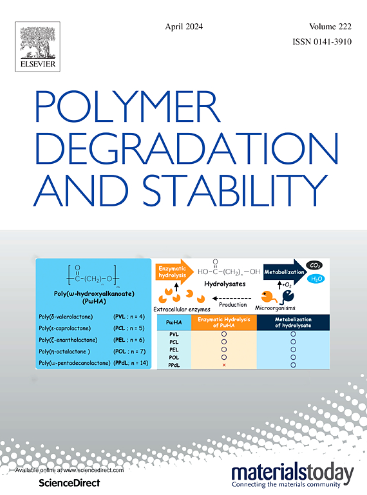Synergistic engineering of phosphaphenanthrene and ionic liquids for unlocking flame retardant multifunctional epoxy resin with high performances
IF 6.3
2区 化学
Q1 POLYMER SCIENCE
引用次数: 0
Abstract
Herein, we presented a multifunctional epoxy resin (EP) composite prepared by the synergistic combination of DOPO and ionic liquids (ILs). The optimized EP-DOPO/ILs system demonstrated exceptional flame retardancy, with only 3 wt% of flame retardant (DOPO/ILs) added to achieve UL-94 V-0 grade for EP and a limiting oxygen index (LOI) of 33.4 %. Cone calorimeter test revealed 32.2 % and 26.7 % reductions in peak of heat release rate (pHRR) and total smoke production (TSP), respectively, compared to neat EP. Notably, the designed rigid-flexible epoxy network simultaneously enhanced tensile strength to 75.7 MPa (+15.7 %) and impact strength to 24.8 kJ m-2 (+136.3 %), outperforming conventional EP thermosets. Furthermore, the EP composites retained 90 % visible light transmittance while exhibiting ultraviolet (UV) shielding efficiency and intrinsic fluorescence. This multi-component collaborative system provides an important experimental foundation for developing high-performance multifunctional polymeric materials.

磷菲与离子液体协同工程解锁阻燃多功能高性能环氧树脂
本文提出了一种由DOPO和离子液体(ILs)协同组合而成的多功能环氧树脂(EP)复合材料。优化后的EP-DOPO/ILs体系表现出优异的阻燃性,仅添加3 wt%的阻燃剂(DOPO/ILs)即可达到EP的UL-94 V-0级,极限氧指数(LOI)为33.4%。锥形量热计测试显示,与纯EP相比,热释放率峰值(pHRR)和总烟产量(TSP)分别降低了32.2%和26.7%。值得注意的是,设计的刚性-柔性环氧树脂网络同时将抗拉强度提高到75.7 MPa(+ 15.7%),冲击强度提高到24.8 kJ m-2(+ 136.3%),优于传统的EP热固性材料。此外,EP复合材料保持90%的可见光透过率,同时具有紫外线屏蔽效率和固有荧光。这种多组分协同系统为开发高性能多功能高分子材料提供了重要的实验基础。
本文章由计算机程序翻译,如有差异,请以英文原文为准。
求助全文
约1分钟内获得全文
求助全文
来源期刊

Polymer Degradation and Stability
化学-高分子科学
CiteScore
10.10
自引率
10.20%
发文量
325
审稿时长
23 days
期刊介绍:
Polymer Degradation and Stability deals with the degradation reactions and their control which are a major preoccupation of practitioners of the many and diverse aspects of modern polymer technology.
Deteriorative reactions occur during processing, when polymers are subjected to heat, oxygen and mechanical stress, and during the useful life of the materials when oxygen and sunlight are the most important degradative agencies. In more specialised applications, degradation may be induced by high energy radiation, ozone, atmospheric pollutants, mechanical stress, biological action, hydrolysis and many other influences. The mechanisms of these reactions and stabilisation processes must be understood if the technology and application of polymers are to continue to advance. The reporting of investigations of this kind is therefore a major function of this journal.
However there are also new developments in polymer technology in which degradation processes find positive applications. For example, photodegradable plastics are now available, the recycling of polymeric products will become increasingly important, degradation and combustion studies are involved in the definition of the fire hazards which are associated with polymeric materials and the microelectronics industry is vitally dependent upon polymer degradation in the manufacture of its circuitry. Polymer properties may also be improved by processes like curing and grafting, the chemistry of which can be closely related to that which causes physical deterioration in other circumstances.
 求助内容:
求助内容: 应助结果提醒方式:
应助结果提醒方式:


